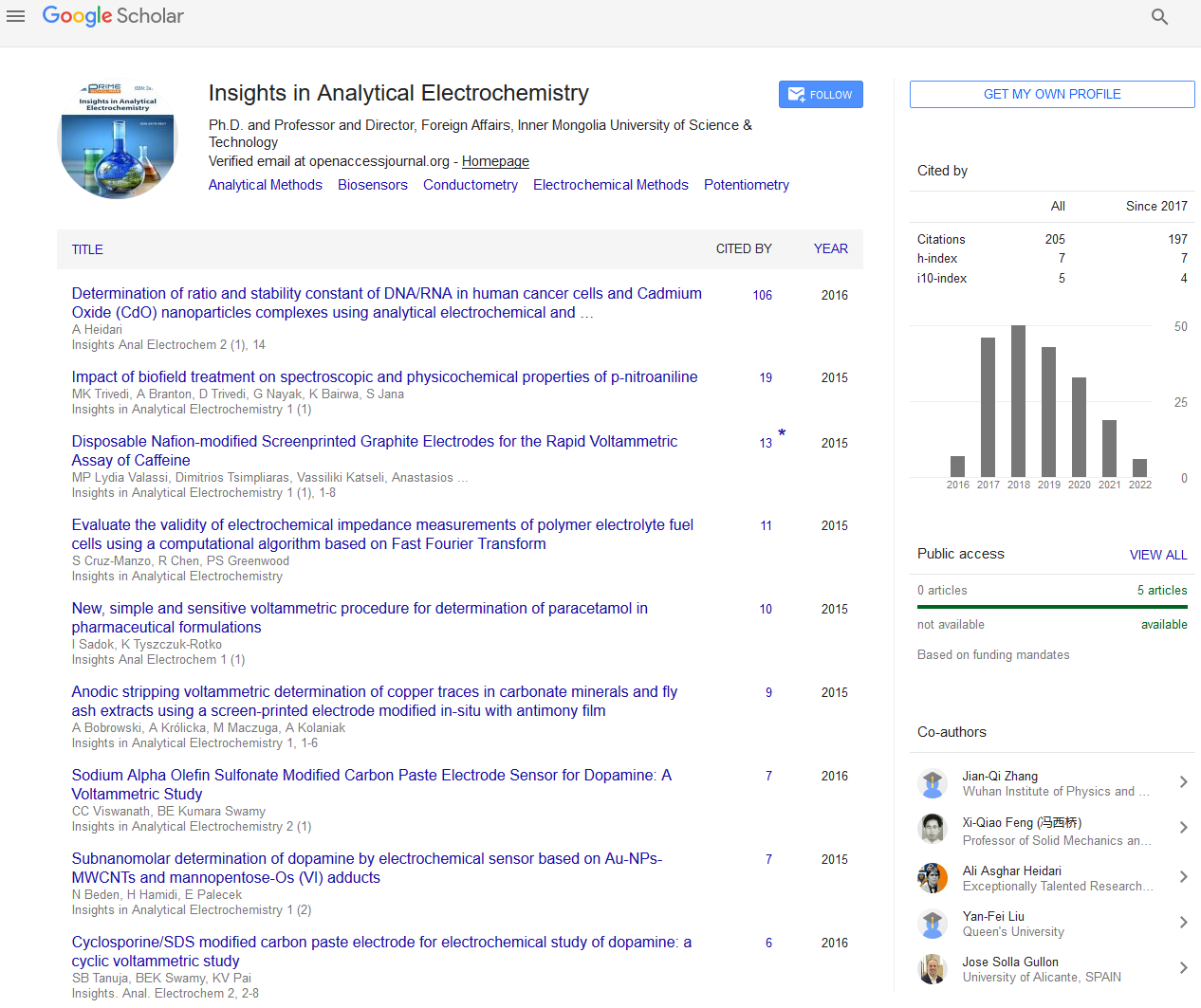Perspective - (2023) Volume 9, Issue 4
Conductometry: Illuminating Chemical Pathways through Electrical Insights
Mehmet Carrere*
Department Chemical Engineering, State University of New York, USA
*Correspondence:
Mehmet Carrere,
Department Chemical Engineering, State University of New York,
USA,
Email:
Received: 29-Nov-2023, Manuscript No. ipaei-24-18855;
Editor assigned: 01-Dec-2023, Pre QC No. ipaei-24-18855 (PQ);
Reviewed: 15-Dec-2023, QC No. ipaei-24-18855;
Revised: 20-Dec-2023, Manuscript No. ipaei-24-18855 (R);
Published:
27-Dec-2023, DOI: 10.21767/2470-9867-9.4.35
Introduction
In the realm of analytical chemistry, precision and accuracy
are paramount. Researchers and scientists continually seek
innovative methods to enhance the reliability of their analyses.
Electrogravimetry, a venerable technique dating back to the
19th century, has proven itself as a robust and precise method
for quantitative analysis. This electrochemical method, rooted
in the principles of electrochemistry and gravimetry, offers a
unique approach to determining the quantity of a substance
in a sample.
Description
At its core, electrogravimetry involves the deposition of
a substance from a solution onto an electrode by passing
an electric current through the solution. The amount of
substance deposited is directly proportional to the quantity
of electricity passed through the system, adhering to
Faraday’s laws of electrolysis. This process leads to the
formation of a solid deposit on the electrode, whose mass
can be accurately measured. The relationship between the
deposited mass and the charge passed provides a foundation
for precise quantitative analysis. One of the key advantages of
electrogravimetry lies in its high precision. Unlike some other
analytical techniques, electrogravimetry is not plagued by
interference from impurities or coexisting ions in the sample.
The method allows for selective deposition of the analyte of
interest, ensuring minimal cross-reactivity with other species
in the solution. This selectivity contributes to the accuracy of
the results, making electrogravimetry particularly useful in
applications where trace amounts of a substance need to be
determined with confidence. Furthermore, electrogravimetry
is known for its versatility. It can be applied to a wide range
of analytes, including metals, metalloids, and even some
non-metals. This versatility extends its utility across various
industries, from environmental monitoring to metallurgy
and pharmaceuticals. Electrogravimetry finds application in
diverse fields, showcasing its versatility and reliability. In the
realm of metallurgy, for instance, it serves as a fundamental
tool for the determination of metal concentrations in ores.
This is crucial for optimizing extraction processes and ensuring
the quality of the final product. In environmental monitoring,
electrogravimetry can be employed to assess the levels of
pollutants in water sources, aiding in the formulation of
effective environmental policies. The method’s reliability has
also made it a valuable tool in pharmaceutical research, where
accurate determination of drug concentrations is essential
for quality control. Electrogravimetry provides a trustworthy
means of quantifying active pharmaceutical ingredients,
contributing to the development of safe and effective
medications. While electrogravimetry has proven its mettle
over the years, it is not without its challenges. The method’s
sensitivity to experimental conditions, such as temperature
and electrode surface characteristics, requires careful control
to ensure reproducibility. Modern advancements, however,
have addressed some of these challenges.
Conclusion
In the ever-evolving landscape of analytical chemistry,
electrogravimetry stands as a venerable technique that has
withstood the test of time. Its inherent precision, versatility,
and reliability make it a valuable tool for researchers and
analysts across various industries. As technology continues to
advance, electrogravimetry is likely to see further refinement
and integration, ensuring its continued relevance in the pursuit
of accurate and reliable quantitative analyses. In an era where
analytical precision is non-negotiable, electrogravimetry
remains a stalwart method, contributing to the foundation of
scientific knowledge and technological progress.
Citation: Carrere M (2023) Conductometry: Illuminating Chemical Pathways through Electrical Insights. Insights Anal Electrochem. 9:35.
Copyright: © 2023 Carrere M. This is an open-access article distributed under the terms of the Creative Commons Attribution License, which permits unrestricted use, distribution, and reproduction in any medium, provided the original author and source are credited.

